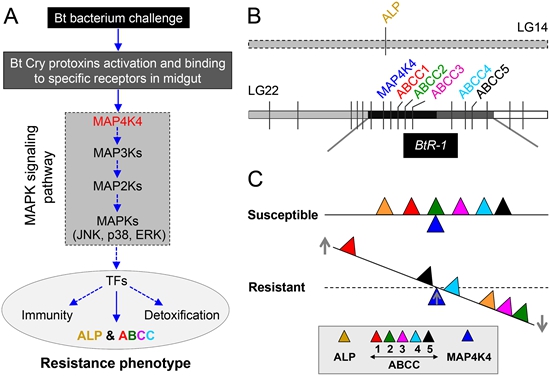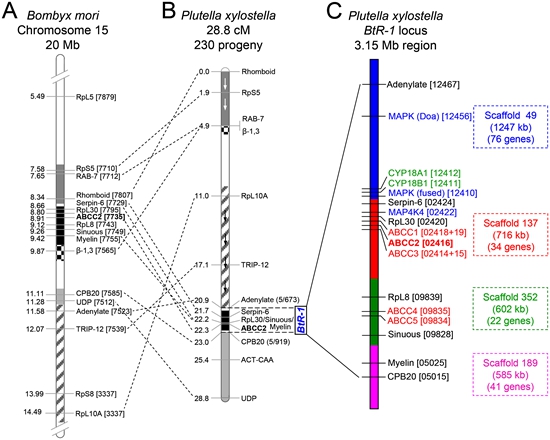分享到
The MAPK-Mediated Differential Expression of Midgut Receptor Genes Confers Resistance to Bt Toxin Cry1Ac in Diamondback Moth
Field-evolved resistance is the most serious threat for the biopesticides and transgenic crops using Cry insecticidal proteins from the bacterium Bacillus thuringiensis (Bt). To date, cases of field-evolved resistance to Bt sprays or Bt crops have been reported in at least seven insect species. The economic and environmental importance of Bt insecticides highlight the significance of clarifying the molecular mechanisms of insect field-evolved resistance to Bt. The diamondback moth, Plutella xylostella, considered as a “super” pest, is the first insect species that has developed resistance to Bt toxins in the field. Cry1Ac resistance in a P. xylostella strain from Hawaii was previously mapped to a mutated ABCC2 gene at the BtR-1 resistance locus.
Recently, the innovation team led by Prof. Youjun Zhang, a senior scientist from Institute of Vegetables and Flowers, Chinese Academy of Agricultural Sciences (IVF-CAAS), identified a novel major mechanistic pathway that the MAPK signaling cascade trans-regulating differential expression of ALP and ABCC genes confers high-level resistance to Cry1Ac in both field-evolved and laboratory-selected strains of P. xylostella (Fig 1). This discovery greatly advances our comprehensive understanding of insect resistance mechanisms to Bt Cry1Ac toxin and provides new insights into how insects evolve resistance to Bt entomopathogen. The excellent work was online published in “PloS Genetics” on April 13, 2015.

Fig 1. Schematic drawing depicting a novel Cry1Ac resistance mechanism in P. xylostella.

Fig 2. Assembly of the chromosomal region of the BtR-1 resistance locus in P. xylostella.
This paper contributes to the overall understanding of the underlying mechanisms of insect Bt resistance in the field. The combined results provide the first comprehensive mechanistic description of field-evolved Bt resistance in P. xylostella and reveal a novel trans-regulatory signaling mechanism responsible for controlling the expression of these pivotal genes in P. xylostella. Extensive studies have shown that expression alteration of receptor genes (e.g. cadherin, ALP, APN and ABCC2) can lead to the development of Bt resistance in many insect species. This overlooked trans-regulatory mechanism sheds light on the holistic understanding of Bt resistance in the field.
For more information please visit:
http://journals.plos.org/plosgenetics/article?id=10.1371/journal.pgen.1005124
Recently, the innovation team led by Prof. Youjun Zhang, a senior scientist from Institute of Vegetables and Flowers, Chinese Academy of Agricultural Sciences (IVF-CAAS), identified a novel major mechanistic pathway that the MAPK signaling cascade trans-regulating differential expression of ALP and ABCC genes confers high-level resistance to Cry1Ac in both field-evolved and laboratory-selected strains of P. xylostella (Fig 1). This discovery greatly advances our comprehensive understanding of insect resistance mechanisms to Bt Cry1Ac toxin and provides new insights into how insects evolve resistance to Bt entomopathogen. The excellent work was online published in “PloS Genetics” on April 13, 2015.

Fig 1. Schematic drawing depicting a novel Cry1Ac resistance mechanism in P. xylostella.
This study used a comprehensive approach, including integrating genetics, biochemical, molecular and genomics toolsets, to investigate the field-evolved Cry1Ac resistance mechanism in P. xylsotella. Based on the previously published genetic linkage data and recent genome information of P. xylostella, they assembled the entire 3.15 Mb BtR-1 locus and analyzed its detailed genetic makeup (Fig 2). They found that quantitative (gene expression alteration) rather than qualitative changes (gene mutation) causes Cry1Ac resistance in both field evolved and lab selected P. xylostella strains. Although a previous study determined Cry1Ac resistance was caused by a mutated ABCC2 gene within BtR-1 locus, they did not identify any mutation in ABCC2 or any other ABCC genes among four independent resistant P. xylostella strains. In contrast, Prof. Zhang’s group presented functional evidence supporting the interaction between a membrane-bound alkaline phosphatase (ALP) outside of BtR-1 locus and two ABC transporter genes (ABCC2 and ABCC3) inside of BtR-1 locus that are tightly linked to the recessive Cry1Ac resistance in P. xylostella. This is the first report showing that expression alterations, not mutations in ABCC2 and other ABCC genes, contribute to Bt resistance. More importantly, the data revealed that the differential expression of these pivotal resistance genes is trans-regulated by a constitutively transcriptionally-activated upstream gene (MAP4K4) in the mitogen-activated protein kinase (MAPK) signaling pathway, a key innate immune pathway.

Fig 2. Assembly of the chromosomal region of the BtR-1 resistance locus in P. xylostella.
This paper contributes to the overall understanding of the underlying mechanisms of insect Bt resistance in the field. The combined results provide the first comprehensive mechanistic description of field-evolved Bt resistance in P. xylostella and reveal a novel trans-regulatory signaling mechanism responsible for controlling the expression of these pivotal genes in P. xylostella. Extensive studies have shown that expression alteration of receptor genes (e.g. cadherin, ALP, APN and ABCC2) can lead to the development of Bt resistance in many insect species. This overlooked trans-regulatory mechanism sheds light on the holistic understanding of Bt resistance in the field.
For more information please visit:
http://journals.plos.org/plosgenetics/article?id=10.1371/journal.pgen.1005124
By Li Lei
lilei@caas.cn
lilei@caas.cn
Latest News
-
 Apr 18, 2024Opening Ceremony of the Training Workshop on Wheat Head Scab Resistance Breeding and Pest Control in Africa Held in CAAS
Apr 18, 2024Opening Ceremony of the Training Workshop on Wheat Head Scab Resistance Breeding and Pest Control in Africa Held in CAAS -
 Apr 03, 2024IPPCAAS Co-organized the Training Workshop on Management and Application of Biopesticides in Nepal
Apr 03, 2024IPPCAAS Co-organized the Training Workshop on Management and Application of Biopesticides in Nepal -
 Mar 28, 2024Delegation from the School of Agriculture and Food Science of University College Dublin, Ireland Visit to IAS, CAAS
Mar 28, 2024Delegation from the School of Agriculture and Food Science of University College Dublin, Ireland Visit to IAS, CAAS -
 Mar 25, 2024Director of World Food Prize Foundation visited GSCAAS
Mar 25, 2024Director of World Food Prize Foundation visited GSCAAS -
 Mar 20, 2024Institute of Crop Sciences (ICS) and Syngenta Group Global Seeds Advance Collaborative Research in the Seed Industry
Mar 20, 2024Institute of Crop Sciences (ICS) and Syngenta Group Global Seeds Advance Collaborative Research in the Seed Industry
